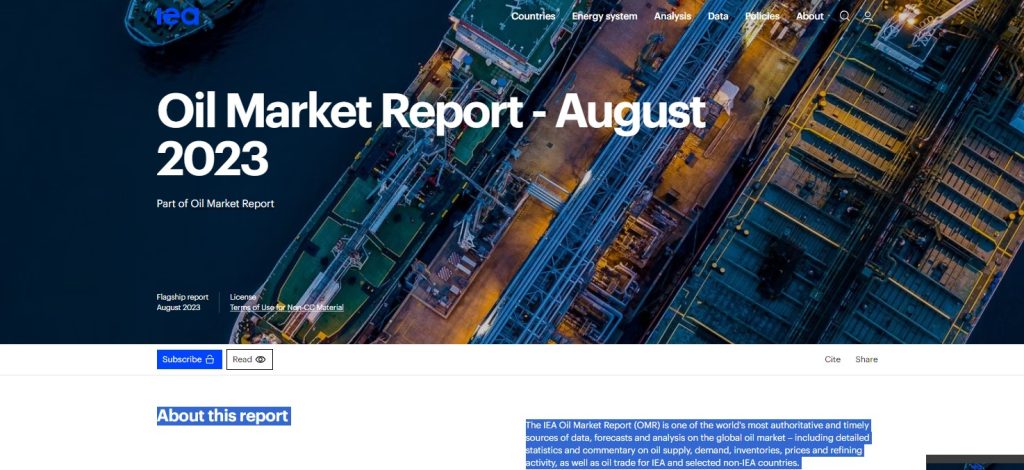Strong Air Traffic, Growing Consumption & Chinese Refinery Activity
Global oil demand is at record highs, helped by strong summer air traffic, increased oil consumption for electricity generation and a surge in Chinese petrochemical activity. Global oil demand is set to grow by 2.2 mb/d to 102.2 mb/d in 2023, with China accounting for more than 70% of the growth. As the post-pandemic recovery falters and lackluster economic conditions, tighter efficiency standards and new electric vehicles weigh on use, growth is expected to slow to 1 mb/d in 2024.
Global oil supply fell by 910 kb/d to 100.9 mb/d in July. A sharp cut in Saudi output in July saw OPEC+ output fall 1.2mb/d to 50.7mb/d, while non-OPEC+ volumes rose 310kb/d to 50.2mb/d. Global oil production is expected to rise by 1.5 mb/d to a record 101.5 mb/d in 2023, with the US leading the non-OPEC+ increase of 1.9 mb/d. Next year, non-OPEC+ is expected to dominate world supply by up to 1.3 mb/d, while OPEC+ could only add 160 mb/d.
Rising Refinery Activity
Refinery throughput is expected to hit a summer high of 83.9 mb/d in August, up 2.4 mb/d from May and up 2.6 mb/d from a year ago. An increase in refined product output failed to ease product market tightness, pushing gasoline and middle distillate spreads to near-record highs. Cracks in high-sulfur fuel oil provided further support for margins, which moved above 2022 levels in July.
Russian crude exports held steady around 7.3 mb/d in July as a 200 kb/d drop in crude supplies was offset by higher product flows. Oil exports to China and India were down month-on-month, but accounted for 80% of Russian shipments. Higher prices of oil, coupled with reducing discounts for Russian grades, swelling estimated export earnings by $2.5 billion to $15.3 billion, down $4.1 billion from a year ago.
Globally monitored oil stocks fell by 17.3 mb in June, led by the OECD. Non-OECD shares and crude oil were largely unchanged. OECD industrial shares reduced 14.7 mb, staying in line with the seasonal trend, to 2,787 mb. Industrial inventories were 115.4 mb below the five-year average, with product inventories particularly tight. Preliminary data indicated that global inventories increased further in July and August.
ICE Brent futures rose $11/bbl to $86/bbl in July as macroeconomic sentiment improved significantly with easing inflation. Tightening of physical balance sheets due to Saudi Arabia output cuts and lower Russian loads added further impetus to the price recovery and pushed crude oil curves deeper into retracement. At the time of writing, Brent was trading around $87/bbl, near the 2023 high.
Highlighting Global Prices
Global oil prices rose steadily throughout July and into early August, reflecting the market tightening long predicted by the report. OPEC+’s deepening supply cuts have clashed with improved macroeconomic sentiment and persistently high global oil demand. North Sea Dated rose $10/bbl on the month to around $85/bbl, the highest since April. Reduction in production have hit the heavy sour market badly, with Dubai crude exchanging hands at a rare premium to Brent, while the trend of prices of Urals oil have crossed a G7-led price ceiling, taking it up to an extent, where brining all Russian oil exports unable for G7 and EU naval and sea services.
In July, OPEC+ oil supplies fell by 1.2 mb/d to a near two-year low as voluntary cuts from Saudi Arabia took effect. At 50.7 mb/d, the block’s production is down more than 2 mb/d since the start of the year. In the same period, non-OPEC+ producers increased production by 1.6 mb/d to 50.2 mb/d, but non-OPEC+ gains are expected to be limited for the rest of the year. The US, Brazil and Guyana are leading the expansion, with exports from the trio rising roughly 15% year-on-year to more than 9 mb/d in July, boosting the availability of light sweet grades in the Atlantic basin. The US accounts for nearly 80% of global supply growth in 2023, or 1.2 mb/d of the total 1.5 mb/d. Next year, that share is set to drop as activity in the shale region slows.
Steady Global Demands
Global oil demand reached a record 103 mb/d in June, and August could see another peak. After months of lackluster data, OECD demand was revised up for May and June, with overall consumption returning to growth in 2Q23 after two-quarters of decline. Chinese demand was also stronger than expected, reaching new highs despite lingering concerns about the health of the economy. Global oil demand looks set to rise 2.2 mb/d this year to 102.2 mb/d, the highest annual level on record. With the post-pandemic recovery largely over and the energy transition accelerating, growth will slow to 1 mb/d in 2024.
Refiners are struggling to keep up with demand growth as a shift to new feedstocks, outages and high temperatures have forced many operators to operate at reduced rates. Tight gasoline and diesel markets pushed margins to six-month highs. While diesel remains under pressure due to competition from cheap LPG and weak petrochemical activity outside China, high-sulfur fuel oil has thinned significantly as refiners replace lost OPEC+ crude with lighter, sweeter grades. Rotterdam’s high-sulphur fuel oil rises above the North Sea Dated for the first time in 28 years.
Falling Inventories for Supplies
As a result, inventories of crude oil and products fell sharply. Observed oil inventories fell for the third month in a row in July, with OECD industrial inventories more than 100 mb below their five-year average. The market balance will further tighten by autumn as Saudi Arabia and Russia extend supply cuts until at least September. OPEC+’s ample spare capacity of 5.7 mb/d means the alliance has considerable room to raise output later in the year. Additional supplies of heavy sour crude would allow refiners to ramp up activity and help ease product market pressures. However, if the bloc’s current targets are maintained, crude inventories could fall by 2.2 mb/d in 3Q23 and 1.2 mb/d in the fourth quarter, with the risk of pushing prices still higher.
The IEA Oil Market Report (OMR), a major energy report, is considered to be an esteemed and respected up-to-date source of global oil market data, key forecasts and analysis. It also presents detailed statistics and commentary on oil supply, demand, inventories, prices and refining activity, as oil trade for the IEA and selected non-IEA countries.



























